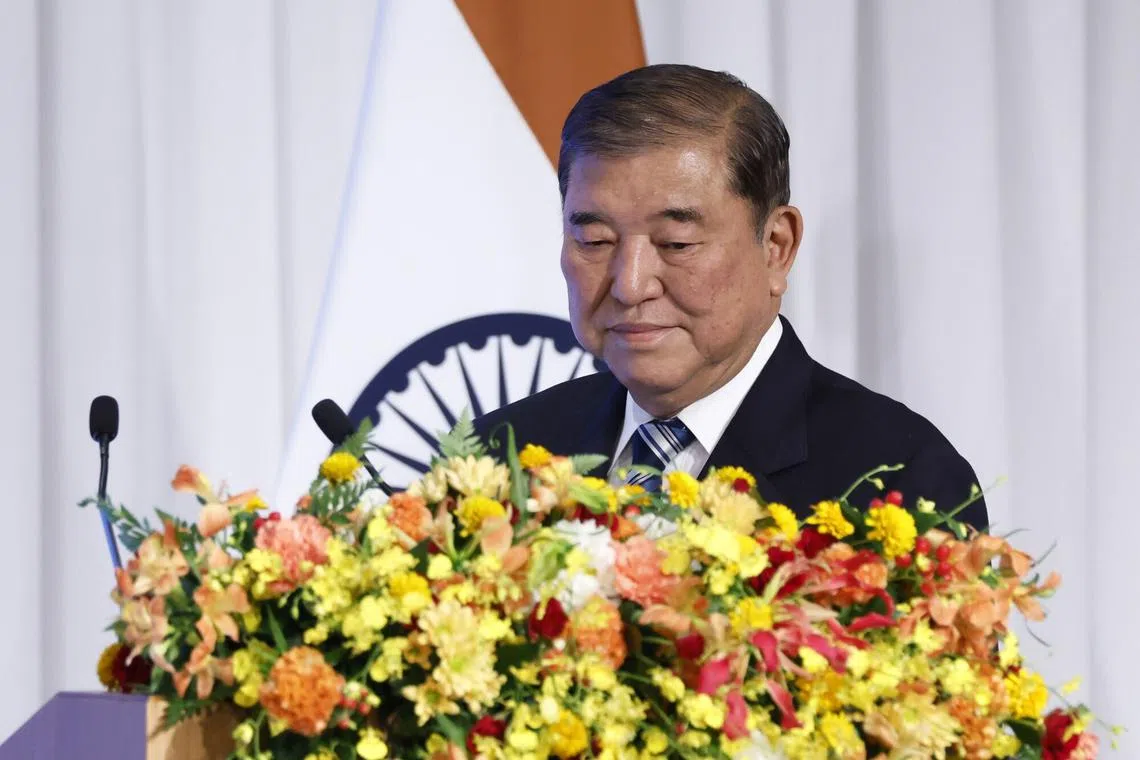Japan PM Ishiba decides to quit to avoid party split as rivals seek leadership change
Sign up now: Get ST's newsletters delivered to your inbox

Japanese Prime Minister Shigeru Ishiba’s LDP-led coalition lost its Upper House majority in an election in July.
PHOTO: BLOOMBERG
Follow topic:
TOKYO – Japanese Prime Minister Shigeru Ishiba has decided to resign to avoid a split within the ruling Liberal Democratic Party (LDP) following disastrous Upper House elections.
The decision comes less than a year after the 68-year-old took the helm of the long-dominant LDP.
He has since lost his majority in both chambers of Parliament.
Public broadcaster NHK said Mr Ishiba made the decision to avoid a split in the party, while the Asahi Shimbun daily said he was unable to withstand the mounting calls for his resignation.
The farm minister and a former prime minister reportedly met with Mr Ishiba late on Sept 6 to urge him to resign voluntarily.
Last week, four senior LDP officials, including the party’s No. 2 Hiroshi Moriyama, offered to resign
Opponents of Mr Ishiba have been calling on him to step down to take responsibility for the election results, following the Upper House vote in July.
LDP lawmakers are scheduled to vote on Sept 8 whether to hold an extraordinary leadership election.
The prime minister’s impending departure will fuel political uncertainty over the coming weeks until the LDP chooses a successor.
Jockeying starts
Media reports suggest that lawmakers are already jockeying to position themselves
Hopefuls will need at least 20 other lawmakers to support their candidacy in order to throw their hats in the ring.
Whoever wins the party contest will then have to win a vote in Parliament to become prime minister in a fractured Diet.
Despite losing its majority, the LDP’s ruling coalition still holds the most seats in the Lower House, positioning its candidate for premier as the most likely to win, though not guaranteeing that outcome.
A priority for the LDP’s next leader will be restoring support for the ruling coalition.
The July election defeat followed a setback in the Lower House last October, shortly after Mr Ishiba took office.
As a result, the LDP has been forced to govern without a majority in either chamber of Parliament for the first time since its founding in 1955.
Potential candidates within the ruling party include Ms Sanae Takaichi, a former internal affairs minister who finished second to Mr Ishiba in an LDP leadership race in 2024; Agriculture Minister Shinjiro Koizumi, the son of a former prime minister; and Mr Takayuki Kobayashi, a former economic security minister.
Mr Yoshimasa Hayashi, the current Chief cabinet secretary, as well as Mr Katsunobu Kato, the finance minister, may also show interest in succeeding Mr Ishiba.
Mr Ishiba will be the third leader to step down since Mr Shinzo Abe, Japan’s longest serving premier, left office in 2020.
The party has yet to fully fill a power vacuum left by Mr Abe’s 2022 assassination
In the Upper House election, the LDP lost a portion of its conservative supporters to Sanseito, a right-wing populist party that has pushed a “Japanese-First” agenda.
The Democratic Party for the People also added seats calling for a boost to take-home pay, while the main opposition Constitutional Democratic Party of Japan held its seat total steady without capitalising on the LDP’s retreat.
An LDP review of election results largely blamed the party itself and its unpopular measures to tackle inflation for the lost seats rather than Mr Ishiba himself, but he still faced a wave of calls to step down from disenchanted lawmakers in his party. REUTERS, AFP, BLOOMBERG

